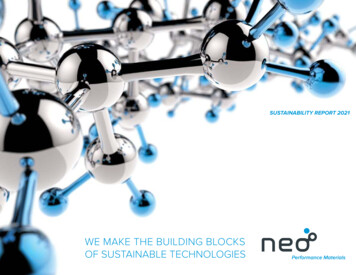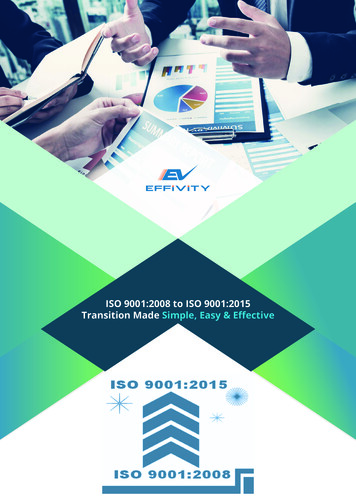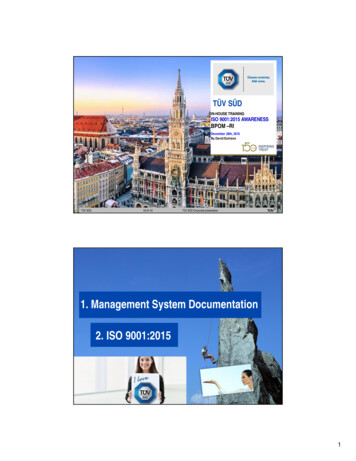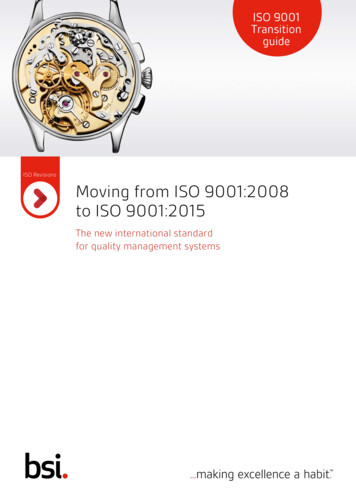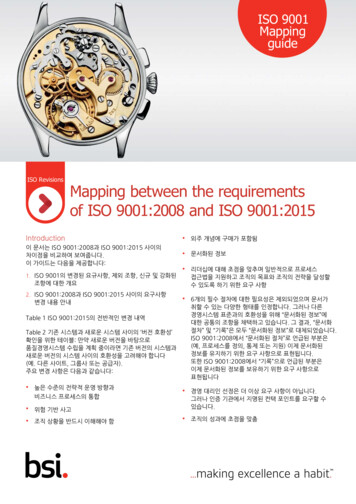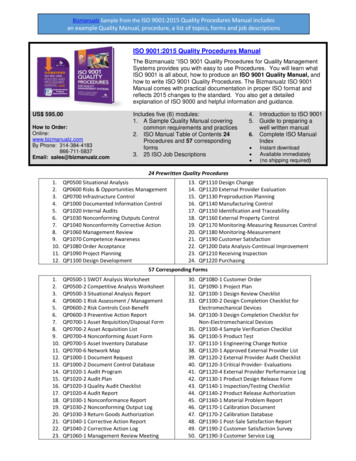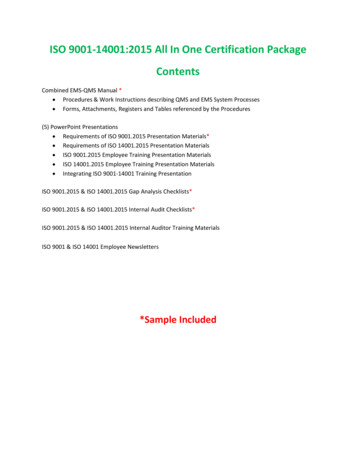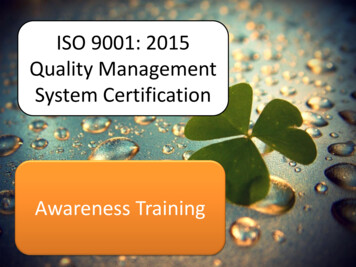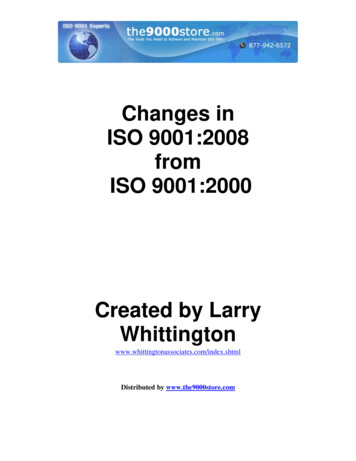
Transcription
Changes inISO 9001:2008fromISO 9001:2000Created by x.shtmlDistributed by www.the9000store.com
ISO 9001:2008 DifferencesISO-IAF Joint PlanAccording to a joint announcement by the ISO (International Organization for Standardization) and theIAF (International Accreditation Forum), the two organizations have agreed to an implementation planfor a smooth migration to ISO 9001:2008.1) Certification of conformity to ISO 9001:2008 will only be issued after publication of ISO 9001:2008(issued November 15, 2008) and after a routine surveillance audit or re-certification audit against ISO9001:2008.2) One year after publication of ISO 9001:2008, all certifications issued (new certifications and recertifications) must be to ISO 9001:2008.3) Two years after publication of ISO 9001:2008, existing ISO 9001:2000 certifications will not be valid.This plan is possible, because ISO and IAF agreed that ISO 9001:2008 introduces no new requirements.The revised quality standard only introduces clarifications to the ISO 9001:2000 requirements, as wellas, changes to improve consistency with ISO 14001:2004, the environmental standard.ISO 9001:2008 DifferencesThe differences in ISO 9001:2008 vs. ISO 9001:2000 are described below. Deleted ISO 9001:2000 text isindicated by strikethroughs. New ISO 9001:2008 text is highlighted and underlined. The underlining willallow readers to distinguish the new text, even if this paper is printed without color.Most of the text in ISO 9001:2000 has not been affected by ISO 9001:2008. Text from the standard isshown in this paper as Italics to distinguish it from comments.Note: This paper on the changes in ISO 9001:2008 has been reproduced by permission of the author,Larry Whittington. You can contact him at Larry@WhittingtonAssociates.com .WhittingtonPage 1 of 19November 2008
ISO 9001:2008 DifferencesISO 9001:2008 - Introduction0.1 GeneralIn the Introduction, ISO 9001:2008 adds “organizational environment”, “change”, and “risk” to the list offactors that influence the design and implementation of a quality management system. The otherchanges to this text are minor revisions to the other factors, as well as, the use of a bulleted list.The design and implementation of an organization's quality management system is influenced by- its organizational environment, change in that environment, and the risks associated with thatenvironment,- its varying needs,- its particular objectives,- the products it provides provided,- the processes it employs employed, and- its the size and organizational structure of the organization.Later in section 0.1, ISO 9001:2008 changes "regulatory" to "statutory and regulatory” and clarifies thatthe customer, statutory, and regulatory requirements are those applicable to the product.This International Standard can be used by internal and external parties, including certification bodies, toassess the organization's ability to meet customer, statutory, and regulatory requirements applicable tothe product, and the organization's own requirements.0.2 Process ApproachIn the Process Approach section, ISO 9001:2008 switches from having to “identify” linked activities to“determine” linked activities. The section clarifies that a Process can be an activity or set of activities.For an organization to function effectively, it has to identify determine and manage numerous linkedactivities. An activity or set of activities using resources, and managed in order to enable thetransformation of inputs into outputs, can be considered as a process.Also in this section, the definition of the Process Approach has been clarified by adding "to produce thedesired outcome" to the text below:The application of a system of processes within an organization, together with the identification andinteractions of these processes, and their management to produce the desired outcome, can be referredto as the "process approach".0.3 Relationship with ISO 9004The planned revision to ISO 9004:2000 is expected in 2009 with extensive changes, including a newclause structure that no longer matches that of ISO 9001.WhittingtonPage 2 of 19November 2008
ISO 9001:2008 DifferencesAs a result, ISO 9001:2008 no longer refers to the two standards as having, "similar structures in order toassist their application as a consistent pair." The title of the revamped ISO 9004 is expected to be,“Managing for the Sustained Success of an Organization - A Quality Management Approach”.The present editions of ISO 9001 and ISO 9004 have been developed as a consistent pair of arequality management system standards which have been designed to complement each other,but can also be used independently. Although the two International Standards have differentscopes, they have similar structures in order to assist their application as a consistent pair.ISO 9001:2008 adds a Note about the upcoming revision to ISO 9004.NOTE: At the time of the publication of this International Standard, ISO 9004 is under revision. Therevised edition of ISO 9004 will provide guidance to management for achieving sustained success for anyorganization in a complex, demanding, and ever changing, environment. ISO 9004 provides a wider focuson quality management than ISO 9001; it addresses the needs and expectations of all interested partiesand their satisfaction, by the systematic and continual improvement of the organization’s performance.However, it is not intended for certification, regulatory, or contractual use.0.4 Compatibility with Other Management SystemsThe change at this section is to refer to ISO 14001:2004 instead of ISO 14001:1996, and to refer to theappendix that compares the clauses of ISO 9001:2008 to the clauses of ISO 14001:2004.This International Standard has been aligned with ISO 14001:1996 in order During the development ofthis International Standard, due consideration was given to the provisions of ISO 14001:2004 to enhancethe compatibility of the two standards for the benefit of the user community. Annex A shows thecorrespondence between ISO 9001:2008 and ISO 14001:2004.ISO 9001:2008 - Scope1. Scope1.1 GeneralThis section still explains that ISO 9001 specifies requirements for a quality management system. Itrefers to the product as meeting customer and applicable “regulatory” requirements, as well as,enhancing customer satisfaction by assuring conformity to customer and applicable “regulatory”requirements. ISO 9001:2008 has expanded the uses of "regulatory" to "statutory and regulatory".a) needs to demonstrate its ability to consistently provide product that meets customer and applicablestatutory and regulatory requirements, andb) aims to enhance customer satisfaction through the effective application of the system, includingprocesses for continual improvement of the system and the assurance of conformity to customer andapplicable statutory and regulatory requirements.The Note at this General section used to say the term "product" applied only to the product intendedfor, or required by, a customer. ISO 9001:2008 has expanded Product to include any intended outputresulting from the product realization processes.WhittingtonPage 3 of 19November 2008
ISO 9001:2008 DifferencesNOTE 1: In this International Standard, the term “product” only applies only to- a the product intended for, or required by, a customer,- any intended output resulting from the product realization processes.A second Note has been added to explain that “statutory and regulatory” requirements can beexpressed as “legal” requirements.NOTE 2: Statutory and regulatory requirements can be expressed as legal requirements.1.2 ApplicationISO 9001:2000 stated that a requirement exclusion cannot affect the organization's ability, orresponsibility, to provide product that meets customer and applicable regulatory requirements. ISO9001:2008 replaces "regulatory" with "statutory and regulatory".Where exclusions are made, claims of conformity to this International Standard are not acceptableunless these exclusions are limited to requirements within Clause 7, and such exclusions do not affect theorganization's ability, or responsibility, to provide product that meets customer and applicable statutoryand regulatory requirements.ISO 9001:2008 – Normative Reference2. Normative ReferenceAlthough the text at this section has been significantly reduced (the deleted text is not shown), the keychange is to refer to ISO 9000:2005 instead of the old ISO 9000:2000.The following referenced documents are indispensable for the application of this document. Fordated references, only the edition cited applies. For undated references, the latest edition of thereferenced document (including any amendments) applies.ISO 9000:20002005, Quality management systems - Fundamentals and vocabularyISO 9001:2008 – Terms and Definition3. Terms and DefinitionsThe change at this section was to no longer explain the supply chain terms, including that "supplier"replaced "subcontractor" and "organization" replaced "supplier". The explanation was needed for thetransition from ISO 9001:1994 to ISO 9001:2000, but not now. The only text remaining is shown below:For the purposes of this document International Standard, the terms and definitions given in ISO 9000apply.Throughout the text of this International Standard, wherever the term “product” occurs, it can also mean“service”.WhittingtonPage 4 of 19November 2008
ISO 9001:2008 DifferencesISO 9001:2008 - Clause 44. Quality Management System4.1 General RequirementsIn 4.1, General Requirements, sub-clause (a), the word "Identify" has been replaced with "Determine".a) Identify Determine the processes needed for the quality management system and their applicationthroughout the organization (see 1.2),Although similar, the words "Identify" and "Determine" have slightly different meanings. To identify is torecognize or establish something as being a particular thing. To determine is to apply reason and reach adecision. To determine the processes implies more analysis and judgment than merely identifying them.e) monitor, measure where applicable, and analyze these processes, and .Processes are monitored, but may not need to be measured. Therefore, the requirement change aboveindicates processes are only measured where applicable.Later in clause 4.1, regarding outsourcing:Where an organization chooses to outsource any process that affects product conformity with torequirements, the organization shall ensure control over such processes. Control of such The type andextent of control to be applied to these outsourced processes shall be identified defined within thequality management system.This addition clarifies that specific controls are to be defined and applied, not just identified. See thenew Note 3 below for an explanation of the type and extent of controls for an outsourced process.The current Note under clause 4.1 has been expanded and two new Notes have been added:NOTE 1: Processes needed for the quality management system referred to above should includeprocesses for management activities, provision of resources, product realization, and measurement,analysis, and improvement.The text above expands from "measurement" to "measurement, analysis, and improvement" to matchthe title for clause 8. And, by deleting "should", it clearly states that these processes are included.The new Note below provides an explanation of what is considered an outsourced process.NOTE 2: An outsourced process is a process that the organization needs for its quality managementsystem and which the organization chooses to have performed by an external party.WhittingtonPage 5 of 19November 2008
ISO 9001:2008 DifferencesThe new Note below identifies the factors influencing the control of an outsourced process.NOTE 3: Ensuring control over outsourced processes does not absolve the organization of theresponsibility of conformity to all customer, statutory, and regulatory requirements. The type and extentof control to be applied to the outsourced process can be influenced by factors such asa) the potential impact of the outsourced process on the organization's capability to provide product thatconforms to requirements,b) the degree to which the control for the process is shared;c) the capability of achieving the necessary control through the application of clause 7.4.Outsourcing a process to another organization typically involves the purchase of those services. As aresult, the requirements of clause 7.4, including the controls mentioned in 7.4.1, apply equally to thesupplier selected to perform the outsourced process.4.2 Documentation Requirements4.2.1 GeneralThe changes in this section are basically just a restructuring of the sub-clauses c), d), and e).c) documented procedures and records required by this International Standard, andd) documents, including records, needed determined by the organization to be necessary to ensure theeffective planning, operation and control of its processes. ,ande) records required by this International Standard (see 4.2.4).You can see that adding "records" to sub-clause (c) allowed sub-clause (e) to be dropped. Sub-clause (d)has been expanded to include the necessary records.The first Note for clause 4.2.1 has added two more sentences:A single document may include the requirements for one or more procedures. A requirement for adocumented procedure may be covered by more than one document.An example for the first sentence would be satisfying the requirements for documented procedures in8.5.2, Corrective Action, and 8.5.3, Preventive Action, through one combined Corrective and PreventiveAction procedure. An example for the second sentence would be splitting the required procedure forthe Control of Documents into two separate documented procedures.WhittingtonPage 6 of 19November 2008
ISO 9001:2008 Differences4.2.2 Quality ManualNo changes in ISO 9001:2008.4.2.3 Control of DocumentsThe opening sentence of this clause in ISO 9001:2008 still states that documents required by the qualitymanagement system are to be controlled. The only revision to clause 4.2.3 is shown below:f) to ensure that documents of external origin determined by the organization to be necessary for theplanning and operation of the quality management system are identified and their distributioncontrolled, andThe change in sub-clause (f) clarifies that not all external documents have to be identified andcontrolled; only those needed for the planning and operation of the quality management system.4.2.4 Control of RecordsThe opening sentence for clause 4.2.4 has expanded from records being "maintained" to having them"controlled". Maintaining records would simply keep them in good condition. Controlling the recordsmeans to regulate their use.Records shall be established and maintained to provide evidence of conformity to requirements and ofthe effective operation of the quality management system shall be controlled.Records shall remain legible, readily identifiable and retrievable.The organization shall establish a documented procedure shall be established to define the controlsneeded for the identification, storage, protection, retrieval, retention time, and disposition of records.Records shall remain legible, readily identifiable, and retrievable.The requirement for a documented Record Control procedure has been rewritten, but the content isbasically the same. It is now a separate paragraph for emphasis and moved up in the section.Note that "retention time" has been reduced to "retention". And, you can see that records must stillremain legible, readily identifiable, and retrievable. This requirement is now a separate paragraph andmoved to the end of clause 4.2.4.WhittingtonPage 7 of 19November 2008
ISO 9001:2008 DifferencesISO 9001:2008 - Clause 55. Management Responsibility5.1 Management Commitment5.2 Customer Focus5.3 Quality Policy5.4 PlanningNo changes in ISO 9001:2008 for clauses 5.1 through 5.4.5.5 Responsibility, Authority, and Communication5.5.1 Responsibility and AuthorityNo changes in ISO 9001:2008.5.5.2 Management RepresentativeMost organizations already appoint a Management Representative that is a member of their ownmanagement team. The change below clarifies that requirement.Top management shall appoint a member of the organization's management who, irrespective of otherresponsibilities, shall have responsibility and authority that includes:Some companies in the past have outsourced the Management Representative role to someone in adifferent organization, or even to their consultant. This text change may be aimed at that practice.5.5.3 Internal CommunicationNo changes in ISO 9001:2008.5.6 Management ReviewNo changes in ISO 9001:2008.ISO 9001:2008 - Clause 66. Resource Management6.1 Provision of ResourcesNo changes in ISO 9001:2008.6.2 Human Resources6.2.1 GeneralThe revision below changes from work affecting "product quality" to work affecting "conformity toproduct requirements". Since quality is the degree to which a set of inherent characteristics fulfilsrequirements, then product quality would be the degree of conformity to product requirements.WhittingtonPage 8 of 19November 2008
ISO 9001:2008 DifferencesPersonnel performing work affecting conformity to product quality requirements shall be competent onthe basis of appropriate education, training, skills and experience.The revision above should not be viewed as a new requirement. Anyone performing, verifying, ormanaging work within the scope of the quality management system, including supporting services, canaffect conformity to product requirements. A new Note has been added to 6.2.1 to explain this point.NOTE: Conformity to product requirements can be affected directly or indirectly by personnel performingany task within the quality management system.6.2.2 Competence, Training, and Awareness, and TrainingThis clause title has been changed from "Competence, Awareness, and Training" to "Competence,Training, and Awareness". Awareness comes from some form of training and should be last in the title.And, that is also the sequence of the requirements as listed within clause 6.2.2.The change in 6.2.1 from “product quality” to “product requirements” has been made to this sub-clause:a) determine the necessary competence for personnel performing work affecting conformity to productquality requirements,Use below of the phrase "where applicable" recognizes that training or other actions may not benecessary, since individuals may already have the necessary competence. And, since "these needs"could be taken out of context, the requirement has been revised to specifically mention competence.b) where applicable, provide training or take other actions to satisfy these needs achieve the necessarycompetence,6.3 InfrastructureThe only change in 6.3 was to add "information systems" as an example of a supporting service.c) supporting services (such as transport, or communication, or information systems).6.4 Work EnvironmentThe only change in 6.4 was to add a Note to explain the term “work environment” by giving examples ofwork environment conditions for achieving conformity to product requirements.NOTE: The term "work environment" relates to those conditions under which work is performed includingphysical, environmental, and other factors (such as noise, temperature, humidity, lighting, or weather).WhittingtonPage 9 of 19November 2008
ISO 9001:2008 DifferencesISO 9001:2008 - Clause 77. Product Realization7.1 Planning of Product RealizationThe only significant change to the text of clause 7.1 is the addition of "measurement" as one of therequired activities to be determined during the planning of product realization.In planning product realization, the organization shall determine the following, as appropriate:b) the need to establish processes, and documents, and to provide resources specific to the product;c) required verification, validation, monitoring, measurement, inspection and test activities specific to theproduct and the criteria for product acceptance;7.2 Customer-Related Processes7.2.1 Determination of Requirements Related to the ProductThe change below from "related" to "applicable" shifts from determining legal requirements that aremerely associated with the product to those that are relevant and can be applied to the product.The organization shall determine:c) statutory and regulatory requirements related applicable to the product, andSince the bulleted list for 7.2.1 begins with "The organization shall determine", the use of the word"determined" again in the entry below was not appropriate. The new text clarifies that the additionalrequirements “considered necessary” must be determined.d) any additional requirements determined considered necessary by the organization.Organizations may not have considered the breadth of post-delivery activities as described by the newNote below.NOTE: Post delivery activities include, for example, actions under warranty provisions, contractualobligations such as maintenance services, and supplementary services such as recycling or final disposal.7.2.2 Review of Requirements Related to the Product7.2.3 Customer CommunicationNo changes in ISO 9001:2008.WhittingtonPage 10 of 19November 2008
ISO 9001:2008 Differences7.3 Design and Development7.3.1 Design and Development PlanningClause 7.3.1.b continues to state that the organization must determine the review, verification, andvalidation appropriate for each design and development stage. The new Note below explains thatalthough review, verification, and validation have distinct goals, they can be carried out separately or inany combination.NOTE: Design and development review, verification and validation have distinct purposes. They can beconducted and recorded separately or in any combination, as suitable for the product and theorganization.7.3.2 Design and Development InputsThis clause continues to require the design and development inputs to be determined and records to bemaintained. It lists several types of requirements to be included. The revision below simply changesfrom "These inputs" to "The inputs".These The inputs shall be reviewed for adequacy. Requirements shall be complete, unambiguous and notin conflict with each other.7.3.3 Design and Development OutputsThe change below removes the unnecessary word, "provided". It also switches from "a form thatenables verification" to "a form suitable for verification". To enable something is to make it possible.However, to be suitable means it is meant for use, or in this case, for verification.The outputs of design and development shall be provided in a form that enables suitable for verificationagainst the design and development input and shall be approved prior to release.The change below was to simply remove the word “for”.b) provide appropriate information for purchasing, production, and for service provision,The new Note below reminds the reader that clause 7, Production and Service Provision, includes subclause 7.5.5, Preservation of Product. Why do that? To indicate that the design output should considerproduct preservation, e.g., product packaging.NOTE: Information for production and service provision can include details for the preservation ofproduct.7.3.4 Design and Development Review7.3.5 Design and Development verification7.3.6 Design and Development ValidationNo changes in ISO 9001:2008 for clauses 7.3.4 through 7.3.6.7.3.7 Control of Design and Development ChangesThe two paragraphs in this section were merged into one paragraph. No text changes.WhittingtonPage 11 of 19November 2008
ISO 9001:2008 Differences7.4 PurchasingNo changes in ISO 9001:2008.7.5 Production and Service Provision7.5.1 Control of Production and Service ProvisionThis clause continues to require planning and carrying out production and service provision undercontrolled conditions. However, two of the listed six conditions have been revised.Later in the standard, the title of clause 7.6 has been changed to refer to the control of monitoring andmeasuring “equipment” instead of “devices”, therefore, the terminology has been changed below:d) the availability and use of monitoring and measuring devices equipment,The change below simply clarifies that the implementation activities are those related to the “product”.f) the implementation of product release, delivery, and post-delivery activities.7.5.2 Validation of Processes for Production and Service ProvisionThe revised text in this clause makes clear that any process output that can't be verified may result indeficiencies becoming known only after the product is in use or the service has been delivered.The organization shall validate any processes for production and service provision where the resultingoutput cannot be verified by subsequent monitoring or measurement. This includes any processes whereand, as a consequence, deficiencies become apparent only after the product is in use or the service hasbeen delivered.7.5.3 Identification and TraceabilityThis clause continues to state that, where appropriate, the organization must identify the product bysuitable means "throughout product realization". The text below refers to inspection and test status ofthe product, and some organizations may have thought it only applied to the final product. The revisionbelow clarifies that identifying the product monitoring and measurement status applies throughoutproduct realization, from received product to final product, including in-process product.The organization shall identify the product status with respect to monitoring and measurementrequirements throughout product realization.By moving the "records" reference to the end of the sentence below, the meaning has expanded fromrecording the product identification, to keeping any type of record associated with product traceability.Where traceability is a requirement, the organization shall control and record the unique identification ofthe product and maintain records (see 4.2.4).7.5.4 Customer PropertyThe change below reads better, but hasn't changed the requirement to report customer property issuesto the customer and keep records.WhittingtonPage 12 of 19November 2008
ISO 9001:2008 DifferencesIf any customer property is lost, damaged, or otherwise found to be unsuitable for use, this shall bereported the organization shall report this to the customer and records maintained maintain records (see4.2.4).The existing Note in 7.5.4 has been revised to include "personal data" as an example of customerproperty, broadening its applicability to more organizations, especially service organizations.NOTE: Customer property can include intellectual property and personal data.7.5.5 Preservation of productIf anyone was confused over the meaning of "conformity of product" in the current text, using"conformity to requirements" should be easier to understand in the new text.The organization shall preserve the conformity of product during internal processing and delivery to theintended destination in order to maintain conformity to requirements.The current requirement that begins with, "This preservation shall include", doesn't give the flexibility toinclude, or not include, the identification, handling, packaging, storage, and protection of the product.The change below allows product preservation to be applied as applicable.This As applicable, preservation shall include identification, handling, packaging, storage, and protection.Preservation shall also apply to the constituent parts of a product.7.6 Control of Monitoring and Measuring Devices EquipmentThe second clause title to change in ISO 9001:2008 is clause 7.6, where "devices" has been changed to"equipment". The term equipment was already used in several places in clause 7.6. The term “devices”has a broader scope and could include non-equipment types of tools. Equipment is the better choice forthis calibration clause.The changes to the clause below are to replace "devices" with "equipment" and to remove thereference to clause 7.2.1, Determination of Requirements Related to the Product.The organization shall determine the monitoring and measurement to be undertaken and the monitoringand measuring devices equipment needed to provide evidence of conformity of product to determinedrequirements (see 7.2.1).A minor change to 7.6 (a) is shown below. This requirement went from "calibrated or verified" to"calibrated or verified, or both", meaning a type of equipment might be calibrated and/or verified.Where necessary to ensure valid results, measuring equipment shall:a) be calibrated or verified, or both, at specified intervals, or prior to use, against measurementstandards traceable to international or national measurement standards; where no such standards exist,the basis used for calibration or verification shall be recorded (see 4.2.4);WhittingtonPage 13 of 19November 2008
ISO 9001:2008 DifferencesThe prior statement below, that measuring equipment must "be identified" sounded like theorganization was to add identification. However, the measuring equipment may come with theidentification already in place.c) be identified have identification to enable in order to determine the its calibration status to bedetermined;The text below was split from its old paragraph and made a standalone sentence for emphasis.Records of the results of calibration and verification shall be maintained (see 4.2.4).Software development organizations may have been unsure how to “confirm”, per clause 7.6, thatsoftware used for monitoring and measurement has the ability to satisfy the intended application.A new Note was added to explain that confirmation of software would typically include verification andconfiguration management.NOTE: Confirmation of the ability of computer software to satisfy the intended application wouldtypically include its verification and configuration management to maintain its suitability for use.The prior Note for clause 7.6 was drop
ISO 9001:2008 Differences The differences in ISO 9001:2008 vs. ISO 9001:2000 are described below. Deleted ISO 9001:2000 text is indicated by strikethroughs. New ISO 9001:2008 text is highlighted and underlined. The underlining will allow readers to distinguish the new text, even if this paper is printed without color.

